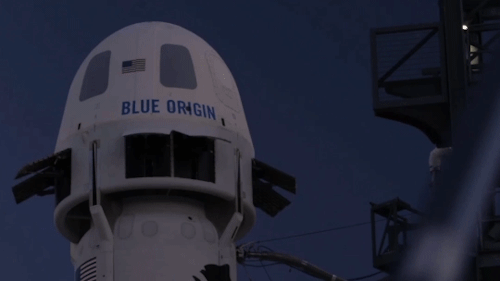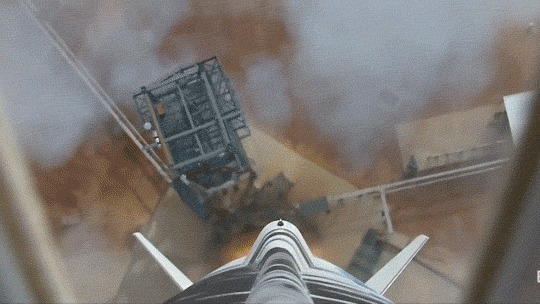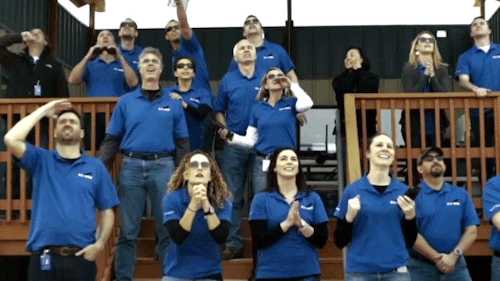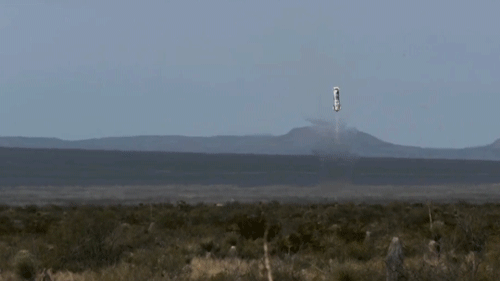This Is Your Closest Look Yet At A Kuiper Belt Object

This is your closest look yet at a Kuiper Belt object
More Posts from Curiositytherover and Others

Prototype Robotic Lunar Lander, Testing at Marshall Space Flight Center
Source: http://www.nasa.gov/images/content/388176main_0901812_full.jpg

Pale Blue Dot, taken by Voyager 1 in 1990 as it left the Solar System, 3.7 billion miles away.
Source: https://imgur.com/Hc4lkLG







Via his very first tweet, Jeff Bezos announced that his spaceflight company has accomplished a historic first. It sent a rocket to the edge of space and then landed that rocket’s main fuselage gently on dry land.
Most things humans have sent into space are pushed up there by a disposable rocket. Once the rockets do their job, they fall back to earth, usually worse for wear. They have to be rebuilt each time (though sometimes their parts can be reused). That’s an expensive process, especially if you are a private company hoping to bring tourists to space. Virgin Atlantic, Elon Musk’s company SpaceX and Bezos’ Blue Origin all want to do just that.
And now Blue Origin has paved the way, landing its rocket on its second attempt (the propulsion module was destroyed when they first tried). Here’s the video in full:
Elon Musk responded to the news on Twitter. He pointed out that it requires much greater speed to actually reach orbit than it does to reach the edge of space. (Phil Plait has some good analysis of the exchange over on his Bad Astronomy blog.)
Still, it’s a pretty amazing accomplishment.
The Force Awakens: China Readies for Space Warfare
Moscow (Sputnik) Jan 01, 2016 The Chinese military is undergoing a gradual shift to cyber and space warfare, and the move is more visible now as a new command structure has been created. After testing an anti-satellite weapon last fall, China moved one step forward in its preparations for future warfare, with the emergence of a brand-new Space Force, as reported by Washington Times. In the event of an armed confl Full article

The New York City Department of Consumer Affairs compared nearly 800 products with female and male versions — meaning they were practically identical except for the gender-specific packaging — and uncovered a persistent surcharge for one of the sexes. Controlling for quality, items marketed to girls and women cost an average 7 percent more than similar products aimed at boys and men.


One minute blood typing
A collaboration between Monash University and Haemokinesis Pty Ltd has resulted in a momentous breakthrough in world health. The creation of a novel category of low cost paper diagnostics that can identify a person’s blood group in just one minute the innovation is named Group Legible Immunohematology Format (GLIF).
GLIF enables quick and easy blood typing, without the need for laboratory equipment, expertise or interpretation of results. Within one minute a written result is returned to the user. This concept can be used anywhere, by anyone, the applications are endless; third world countries, multi-trauma events, countries with heavy conflict to name but a few.
This Australian made and licenced technology was created following a long standing partnership between Monash University and Haemokinesis with funding provided by the Australian Research Council (ARC) under the criteria of a Linkage project.

In parts of Antarctica, not only is it winter, but the Sun can spend weeks below the horizon.At China's Zhongshan Station, people sometimes venture out into the cold to photograph a spectacular night sky.The featured image from one such outing was taken in mid-July, just before the end of this polar night.Pointing up, the wide angle lens captured not only the ground at the bottom, but at the top as well. In the foreground is a colleague also taking pictures.In the distance, a spherical satellite receiver and several windmills are visible.Numerous stars dot the night sky, including Sirius and Canopus.Far in the background, stretching overhead from horizon to horizon, is the central band of our Milky Way Galaxy.Even further in the distance, visible as extended smudges near the top, are the Large and Small Magellanic Clouds, satellite galaxies near our huge Milky Way Galaxy.
Credit: NASA
Time And Space
![Magnified Universe [more]](https://64.media.tumblr.com/197c7ee2475a77605a8816687657e418/tumblr_nyjo97H9BI1s819puo1_500.png)
![Magnified Universe [more]](https://64.media.tumblr.com/84d8d8b852eae770892412d1cc8fe292/tumblr_nyjo97H9BI1s819puo2_500.png)
![Magnified Universe [more]](https://64.media.tumblr.com/0c4b9a665058e3836b60f622f1f0609a/tumblr_nyjo97H9BI1s819puo3_500.png)
![Magnified Universe [more]](https://64.media.tumblr.com/de0cd3dc514b3e64e3e88b9de9e0adc9/tumblr_nyjo97H9BI1s819puo4_500.png)
![Magnified Universe [more]](https://64.media.tumblr.com/100047dd8f124eeb1b3f3ee0b21524fc/tumblr_nyjo97H9BI1s819puo5_500.png)
![Magnified Universe [more]](https://64.media.tumblr.com/e69f4879cf17a7a81f7d2b4334aa3873/tumblr_nyjo97H9BI1s819puo6_500.png)
![Magnified Universe [more]](https://64.media.tumblr.com/ec3c6c7c24857c4e2219cf2676953232/tumblr_nyjo97H9BI1s819puo7_500.png)
![Magnified Universe [more]](https://64.media.tumblr.com/1513bc2928b65ad61b12c18ef82b191f/tumblr_nyjo97H9BI1s819puo8_500.png)
![Magnified Universe [more]](https://64.media.tumblr.com/82dd885da9ec482c369820a590febdce/tumblr_nyjo97H9BI1s819puo9_500.png)
![Magnified Universe [more]](https://64.media.tumblr.com/8bc1203743e917491c4989e5afd1fa3b/tumblr_nyjo97H9BI1s819puo10_500.png)
Magnified Universe [more]

We pulled together the week’s top tech stories, just for you:
1. Formula E is planning the first racing series for driverless cars You read that right: Before every Formula E race, two autonomous vehicles will go head-to-headlights, in a race straight out of every Sci-Fi fan’s wildest dreams. via: @engadget
2. How Technology Will Transform Retirement Someday in the near future, being selfish and obsessed with technology might be qualities that senior citizens praise today’s Millennials for. All around the world, young people are hard at work creating technology that will take care of them when they’re older. via: The Wall Street Journal
3. Who’s going to fly those Amazon delivery drones? The short answer is, probably no one. Which is for the best, really. After all, the real reason we don’t have flying cars is because people are bad drivers. And adding a z axis would be like trying to navigate rush-hour traffic in midair. via: ZDNet
4. Wayfindr Is on a Quest to Optimize Cities for the Visually Impaired After a successful experiment at London’s Pimlico Station and a recently received grant of $1 million from Google.org, this company wants to change the way visually impaired commuters navigate the London Underground. via: @wired
-
 healmet-blog liked this · 9 years ago
healmet-blog liked this · 9 years ago -
 clavierm reblogged this · 9 years ago
clavierm reblogged this · 9 years ago -
 clavierm liked this · 9 years ago
clavierm liked this · 9 years ago -
 curiositytherover reblogged this · 9 years ago
curiositytherover reblogged this · 9 years ago -
 theingeniousgentlemanchrisjones liked this · 9 years ago
theingeniousgentlemanchrisjones liked this · 9 years ago -
 thinkbolt liked this · 9 years ago
thinkbolt liked this · 9 years ago -
 engadget reblogged this · 9 years ago
engadget reblogged this · 9 years ago